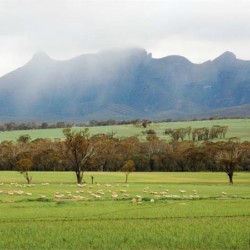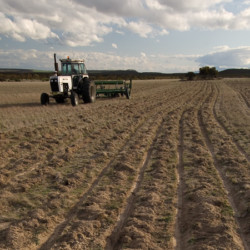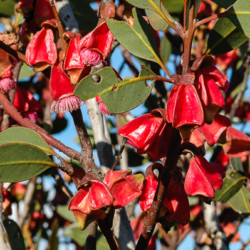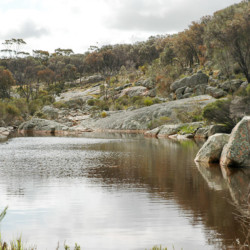In the central zone, the focus is on connecting and consolidating the remaining habitats through large scale and high-quality restoration, while also increasing the scale and effectiveness of conservation management across different tenures.
Natural values
This zone extends from the Walpole Wilderness Area across the Stirling Range and Fitzgerald River national parks to the Ravensthorpe area. The national parks are global icons for the conservation of Mediterranean ecosystems, and include mallee and kwongkan systems richer in plant species than many of the world’s rainforests. Recent survey work is shows that what habitats are left in the surrounding areas are just as rich. In fact, most of the botanical hotspots, within the larger global biodiversity hotspot of south-western Australia, are within this zone. Additionally, many wildlife species, once widespread in the central and southern wheatbelt further north, are now confined to the larger vegetated habitats of this zone.
Habitat types across here range from the Jarrah-Marri forest, and even outliers of the Karri forest, through to vast areas of mallee and kwongkan heaths. There are also small areas of woodland, but these were extensively cleared as they grow on the most fertile soils. The landscape is largely subdued (a WA phrase for ‘flat’) with occasional outstanding features, such as the Porongurups and Stirling ranges. There are a number of short rivers that drain to the coast, though many areas drain internally, into fresh wetlands or small salt lakes.

Stresses
Key stresses identified in our conservation planning work include changed fire regimes, the impact of feral animals and weeds, and sedimentation of river systems. While some large conservation reserves remain, notably the Stirling Range, Fitzgerald River National Parks and Lake Magenta Nature Reserve (115,900ha, 330,000ha, 108,000 ha respectively), and there are still some significant habitat areas on private land, the scale of habitat loss and fragmentation is such that many species have been lost already, disrupting the larger ecosystem processes. Additionally, the overall ecological system may be too fragmented to survive current stresses and the impact of climate change.
Large areas of the Gnowangerup, Jerramungup, Kent and Lake Grace local government areas were only cleared for agriculture since 1948. This is so recent that remaining habitats are yet to experience the ripple effects of the original. Some areas have proved only marginally productive except in wet years. Such areas are relatively easy to restore to biodiverse vegetation cover, and this has been demonstrated by groups and contractors working across the Central Zone in recent years.
Plantation forestry is another significant land-use, particularly in the west and south of the zone, but would appear to have reduced the stress on many remaining habitats, due to exclusion of livestock and the pro-active sustainability work of the companies involved.
Vision
Strategic Objectives for the central zone by 2030:
-
- All major habitats structurally reconnected through strategically placed restoration that effectively makes them one large habitat area with species and genetic material freely moving across the zone.
- Effective on-going management support in place for main habitats across the zone so as to suppress current stresses and strengthen ecological resilience in order for the bushland areas and species to require minimal ongoing management.
- Minimal edge-effect on the core bushland/habitat areas achieved through the spread of ecologically supportive (or at least benign) land-uses surrounding them.
- A functioning restoration economy supporting ongoing conservation priorities through a social fabric and economic activity enriched by the range of new land-uses, industries and activities
The Story so Far
The program started with the purchase and restoration of some initial properties strategically located between Fitzgerald River and Stirling Range national parks. Since that time a number of local groups have joined the effort, and conservation plans are being implemented across all key areas in the Central Zone. There has also been a significant increase in conservation-focused social activity as well, with a constant stream of visitors to key sites, monitoring camp-outs on properties like the Eddy and Donna Wajon’s Chingarrup Sanctuary, and art programs and camps. This important part of the world is now on the map for its conservation values!
Achievements
Since our program began in 2002 there has been substantial progress across the Central Zone, with some 16,000ha secured for conservation and some 13,500ha restored through biodiverse plantings. There has also been a significant increase in conservation-focused activity, including control of feral cats and foxes, monitoring of how wildlife is responding to the restoration work, and a wide range of conservation awareness programs. Social justice has not been forgotten, through the strong emphasis on supporting Noongar endeavours and fostering cross cultural understanding.
Needs
We now have ‘proof of concept’ that that large scale restoration can be achieved, that local communities can benefit, and that wildlife will return. There is widespread community support for transformational change to benefit the environment, and a lot of conservation activity in the Central Zone that now has ‘a life of its own’. We have the conservation and spatial plans in place that enable us to prioritise the key next steps. So we are now working to build on this solid foundation to secure the substantial extra funding required to achieve some 20,000ha of strategically placed restoration that brings the main national parks and reserves back together.
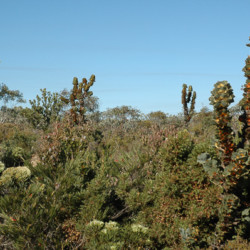
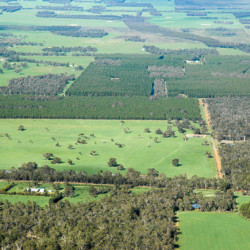
Focus areas
Forest to Stirlings
Lindesay Link
Manypeaks
Ranges Link
Stirlings to Fitzgerald
Ravensthorpe Connection




